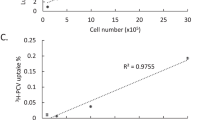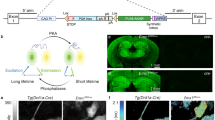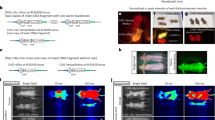Abstract
Through intracellular receptors, estrogens control growth, differentiation and function of not only reproductive tissues, but also other systems1,2,3. Estrogen receptors are ligand-dependent transcription factors whose activity is modulated either by estrogens, or by alternative intracellular signaling pathways downstream of growth factors and neurotransmitters4,5,6. To determine the dynamics of estrogen receptor activity and the dependence of estrogen receptor on 17β-estradiol in vivo, we generated a transgenic mouse that expresses a luciferase reporter gene under the control of activated estrogen receptors. As expected, luciferase activity, monitored with a cooled charged coupled device camera, paralleled circulating estrogen levels in reproductive tissues and in liver, indicating that the peak transcriptional activity of the estrogen receptor occurred at proestrus. In contrast, in tissues such as bone and brain, the peak activity of estrogen receptors was observed at diestrus. These tissue-specific responses are masked when mice undergo conventional hormone treatment. We also demonstrate that estrogen receptors are active in immature mice before gonadal production of sex hormones as well as in ovariectomized adult mice. These findings emphasize the importance of hormone-independent activation of the estrogen receptor, and have implications for the therapeutic use of estrogens, such as hormone replacement therapy.
This is a preview of subscription content, access via your institution
Access options
Subscribe to this journal
Receive 12 print issues and online access
$209.00 per year
only $17.42 per issue
Buy this article
- Purchase on Springer Link
- Instant access to full article PDF
Prices may be subject to local taxes which are calculated during checkout



Similar content being viewed by others
References
Wenger N.K. et al. in International Position Paper on Women's Health and Menopause: a Comprehensive Approach (ed. Wenger N.K.) 1–23 (NIH publication no. 02-3284, Bethesda, MD, 2002).
Ciana, P. et al. Looking at nuclear receptors from the heights of Erice. Workshop on nuclear receptor structure and function. EMBO Rep. 3, 125–129 (2002).
McKenna, N.J., Lanz, R.B. & O'Malley, B.W. Nuclear receptor coregulators: cellular and molecular biology. Endocr. Rev. 20, 321–344 (1999).
Power, R.F. et al. Dopaminergic and ligand-independent activation of steroid hormone receptors. Science 254, 1636–1639 (1991).
Ma, Z.Q. et al. Insulin-like growth factors activate estrogen receptor to control the growth and differentiation of the human neuroblastoma cell line SK-ER3. Mol. Endocrinol. 8, 910–918 (1994).
Kato, S. et al. Activation of the estrogen receptor through phosphorylation by mitogen-activated protein kinase. Science 270, 1491–1494 (1995).
Ciana, P. et al. Engineering of a mouse for the in vivo profiling of estrogen receptor activity. Mol. Endocrinol. 15, 1104–1113 (2001)
Klotz, D.M. et al. Requirement of estrogen receptor-α in insulin-like growth factor-1 (IGF-1)-induced uterine responses and in vivo evidence for IGF-1/estrogen receptor cross-talk. J. Biol. Chem. 8, 8531–8537 (2002).
Wu, J.C., Sundaresan, G., Iver, M. & Gambhir, S.S. Noninvasive optical imaging of firefly luciferase reporter gene expression in skeletal muscles of living mice. Mol. Ther. 4, 297–306 (2001).
Vouret, J.F. et al. Characterization of the hormone responsive element involved in the regulation of the progesterone receptor gene. EMBO J. 10, 1875–1883 (1991).
Shupnik, M.A., Gordon, M.S. & Chin, W.W. Tissue-specific regulation of rat estrogen receptor. Mol. Endocrinol. 3, 660–665 (1989).
Gomez-Benitez, J., Sosa-Gonzalez, A. & Diaz-Chico, B.N. Relation between 3H-estradiol uptake and receptor content of estrogen responsive tissues of castrated female rat. Rev. Esp. Fisiol. 40, 311–317 (1984).
Overpeck, J.G., Colson, S.H., Hohmann, J.R., Applestine, M.S. & Reilly, J.F. Concentrations of circulating steroids in normal prepubertal and adult male and female humans, chimpanzees, rhesus monkeys, rats, mice, and hamsters: a literature survey. J. Toxicol. Environ. Health 4, 785–803 (1978).
Giguère, V., Yang, N., Segui, P. & Evans, R.M. Identification of a new class of steroid hormone receptor. Nature 331, 91–94 (1988).
Heard, D.J., Norby, P.L., Holloway, J. & Vissing, H. Human ERRγ a third member of the estrogen receptor-related (ERR) subfamily of orphan nuclear receptors: tissue-specific isoforms are expressed during development and in the adult. Mol. Endocrinol. 14, 382–392 (2000).
Vanacker, J.M., Pettersson, K., Gustafsson, J.-Å. & Laudet, V. Transcriptional targets shared by estrogen receptor-related receptors (ERRs) and estrogen receptor (ER) α, but not by ERβ. EMBO J. 18, 4270–4279 (1999).
Hong, H., Yang, L. & Stallcup, M.R. Hormone-independent transcriptional activation and coactivator binding by novel orphan nuclear receptor ERR3. J. Biol. Chem. 274, 22618–22626 (1999).
Kamat, A., Hinshelwood, M.M., Murry, B.A. & Mendelson, C.R. Mechanisms in tissue-specific regulation of estrogen biosynthesis in humans. Trends Endocrinol. Metab. 13, 122–128 (2002).
Hashizume, T., Ohtsuki, K. & Matsumoto, N. Plasma insulin-like growth factor-I concentrations increase during the estrous phase in goats. Domest. Anim. Endocrinol. 18, 253–263 (2000).
Sjogren, K. et al. Liver-derived insulin-like growth factor I (IGF-I) is the principal source of IGF-I in blood but is not required for postnatal body growth in mice. Proc. Natl. Acad. Sci. USA 96, 7088–7092 (1999).
Thornton, J.W. Evolution of vertebrate steroid receptors from an ancestral estrogen receptor by ligand exploitation and serial genome expansions. Proc. Natl. Acad. Sci. USA 98, 5671–5676 (2001).
Contag, C.H. et al. Visualizing gene expression in living mammals using a bioluminescent reporter. Photochem. Photobiol. 66, 523–531 (1997).
Honigman, A. et al. Imaging transgene expression in live animals. Mol. Ther. 4, 239–249 (2001).
Wakeling, A.E., Dukes, M. & Bowler, J. A potent specific pure antiestrogen with clinical potential. Cancer Res. 51, 3867–3873 (1991).
Plourde, P.V. et al. ARIMIDEX: a new oral, once-a-day aromatase inhibitor. J. Steroid Biochem. Mol. Biol. 53, 175–179 (1995).
Acknowledgements
We thank P. Chambon for extended discussion; J.Å. Gustafsson, B. Katzenellenbogen, S. Tsai and K. Yamamoto for critical reading of the manuscript; and M. Rebecchi and C. Meda for technical assistance. The present study was supported by Italian Association for Cancer Research, Italian Ministry for Education, CARIPLO, Telethon (E 600), European Community QLRT-2001-02221.
Author information
Authors and Affiliations
Corresponding author
Ethics declarations
Competing interests
The authors declare no competing financial interests.
Rights and permissions
About this article
Cite this article
Ciana, P., Raviscioni, M., Mussi, P. et al. In vivo imaging of transcriptionally active estrogen receptors. Nat Med 9, 82–86 (2003). https://doi.org/10.1038/nm809
Received:
Accepted:
Published:
Issue Date:
DOI: https://doi.org/10.1038/nm809
This article is cited by
-
Sex differences in paternal arsenic-induced intergenerational metabolic effects are mediated by estrogen
Cell & Bioscience (2023)
-
Identification of key genes and molecular mechanisms associated with low egg production of broiler breeder hens in ad libitum
BMC Genomics (2019)
-
Inhibition of SIRT1 deacetylase and p53 activation uncouples the anti-inflammatory and chemopreventive actions of NSAIDs
British Journal of Cancer (2019)
-
Glucuronidation of d-Luciferin In Vitro: Isoform Selectivity and Kinetics Characterization
European Journal of Drug Metabolism and Pharmacokinetics (2019)
-
Application of hairless mouse strain to bioluminescence imaging of Arc expression in mouse brain
BMC Neuroscience (2017)



